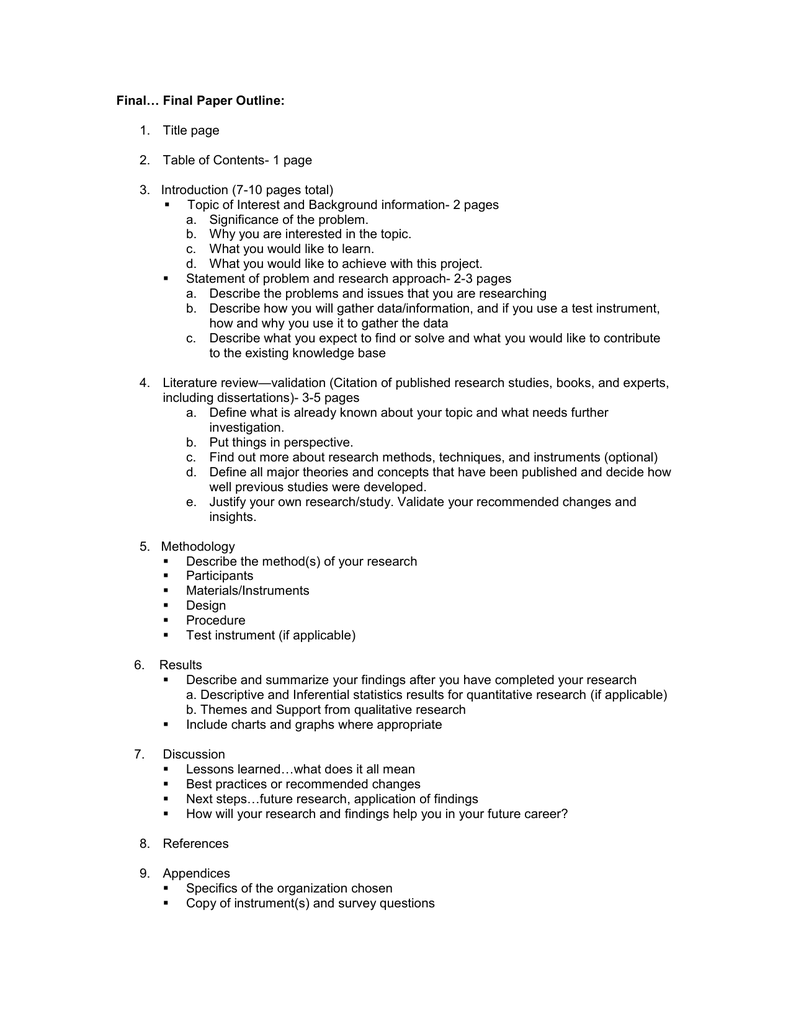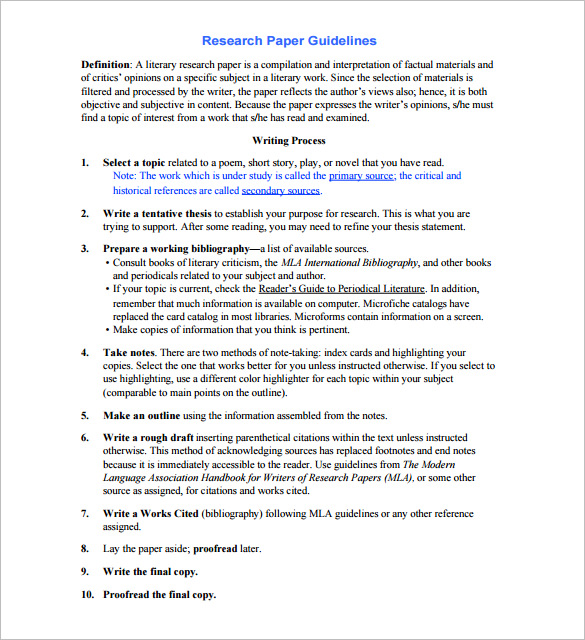
Give your qualitative research paper a title. Write an abstract of the contents. Also compile a table of contents and write an introduction. The introduction should focus your reader on the questions you have explored in your research and will try to answer in your paper 2/21/ · Chapter 3: Methodology (Qualitative/Quantitative/Mixed) Intro; Research Design; Research Hypotheses & Question; Setting/Sample & Population; Participants/Instrumentation; Data Collection; Data Analysis; Concluding section; Chapter 4: Findings. Intro; Findings; Conclusion; Chapter 5: Discussion and Suggestions for Further Research. Intro; Findings Summary; Conclusions; DiscussionEstimated Reading Time: 7 mins Standard Research Paper Outline Format. The following is the standard research paper outline format. It is the basis for creating a successful, more detailed, and high-quality research paper. Introduction. Hook statement. Define the audience. A strong Thesis statement. Body Paragraphs. Arguments to support your thesis statement. Conclusion. Summary of arguments
A Step by Step Guide to Write A Research Paper Outline
Are you in High School, College, Masters, Bachelors or PhD and need assistance with your essay or research paper? All you need is to buy a research paper written by a specialist in your academic field. When you buy a research paper from outline for qualitative research paper, we offer you an original, nil plagiarized dedicated proofreader, writer and editors who is PhD or Masters qualified.
com is an experienced service with over 9 years experience having delivered over 83, essays over the years. Qualitative research is a systematic subjective approach to research used to describe life experiences and give them meaning.
There are six common qualitative research designsthat is, phenomenological, grounded theory, ethnographic, historical, action research and case study. Three of these designs will be outline for qualitative research paper in this paper. Phenomenological Studies. Phenomenological studies are an examination of human experiences through descriptions that are provided by the persons involved.
Such experiences are called lived experiences, outline for qualitative research paper. The main aim of phenomenological studies is to give a description of the meaning that experiences hold for each subject under study. This type of research method is used in the study of areas in which there is little knowledge available.
In phenomenological research, the respondents are asked to give a description of outline for qualitative research paper experiences as they perceive them. They may write about their experiences; however, information is generally obtained through interviewing them. To gain an understanding of the outline for qualitative research paper experience from the vantage point of the subject, the person conducting the research has to take into account their own feeling and beliefs.
The researchers have first to identify what they expect to discover and then deliberately put aside these ideas of their own. This process is called bracketing. Only when the researchers disregard, their own ideas about the phenomenon under study it is possible to see the experience from the eyes of the people who have lived through the experience. The researcher might perceive that he, himself, would feel outline for qualitative research paper frightened and hopeless. These feelings would have to be identified and then disregarded to listen to what the mother is saying about living through the experience of a dying child.
It is very possible that the mother might have discovered an important reason for living while previously she probably hadn't felt needed anymore by her teenage child.
In the research question development, the researcher has to come up with research questions that are relevant to the case under study.
Some of the research questions include: What does the existence of feeling or experience indicate concerning the phenomenon to be explored? And what is the nature of the human being? These research questions will help in guiding the researcher through the research process.
In the data collection methodology, there are no clearly defined steps to carry out the research. This is so as to avoid limiting the creativity of the researcher. A major step involves seeking of persons who understand the study and are willing to express their inner feelings and experiences. These people then describe the experiences of the phenomenon under study to the researcher. The respondents can also write experiences of the phenomenon under study.
The researcher can gain additional data through direct observation and use of audiotape or videotape. Patterns and themes are sought in the data. Collection and analysis of data occur simultaneously. Presentation of the data collected is done through reports that may be published. Ethnographic Studies. Ethnographic studies involve the collection as well as the analysis of data about cultural groups.
Ethnographers try to depict how actions in one world make sense from the point of view of another world. It entails learning from people. It can also be described as the systematic process of observation, detailing, description, documentation, and analysis of the life ways or particular patterns of culture or subculture in order to understand the patterns or life ways of the persons in their familiar environment.
In this researchthe researcher lives with the persons under study and becomes part of their culture. He or she explores with the community their customs and rituals. The subject of the study can be an entire cultural group of a subgroup in the culture.
The term culture can be used in the broad sense to mean the entire tribe of Indians, for instance, or in a more narrow sense to mean one unit of nursing care. The researchers interview persons who are most knowledgeable about the culture under study. These persons are called key informants. Data are generally collected through observation of participants and conduction of interviews.
Just like in phenomenological studies, the researchers identify their own personal biases, outline for qualitative research paper, beliefs and set them aside or disregard them, and then try to gain an understanding of the daily lives of the persons under study as they live them.
The collection and analysis of data occur simultaneously, outline for qualitative research paper. As the researchers gain more understanding of the data, new questions tend to emerge. The end purpose of this type of research is to aid in the development of cultural theories. This method has been used in anthropological research for a long time, outline for qualitative research paper. Quite recently, the method has been adopted in areas such as health care.
In anthropological research, for instance, Margaret Mead in used ii to study the Samoans. This method has been the principle method used by anthropologists to study persons all over the world. The researchers study how people live and how they communicate with one another. The type outline for qualitative research paper questions that this kind of research would answer include: What are the customs of the culture under study? And How do the people in the culture communicate with one another?
The sample size for the study is usually quite large as the researchers have to observe a large sample to be able to understand the cultural aspects of the people under study fully. In the selection of the people to interview, the researcher selects the people who are most knowledgeable in the community and interviews them. Having identified the culture to conduct the study, the researchers identify variables for the study and review available literature.
As mentioned above, data collection involves gaining entrance into the culture, acquiring informants and gathering data through direct observation and interaction with the subjects. Themes and patterns are then sought in the data collected.
Data presentation is usually through reports on what has been observed in the field. Grounded Theory Studies Grounded theory studies are studies outline for qualitative research paper which data are collected and analyzed and then a theory is developed that is based on or grounded in the data collected.
This method utilizes both a deductive and inductive approach to the development of theory. According to Morse and Field"concepts and constructs are grounded in the data while hypotheses are tested as they arise from the research. Grounded theory is a very good method for understanding the processes through which patients manage chronic or new problems relating to health. Each of the persons may manage the health problem in a way that is different from the other person.
For instance, a researcher who is a nurse may be interested in knowing how young women cope with premenstrual syndrome PMS. One woman might be embarrassed to talk about the topic while another may be comfortable to talk about it. Each woman will definitely respond to the topic in their own unique way. Instead of using probability sampling procedures, the researcher uses purposeful sampling. This is to mean that the researcher searches for certain subjects who will be able to give new information on the phenomenon that is outline for qualitative research paper studied.
The researcher seeks diversity rather than similarity in the persons sampled. Data are gathered settings that are naturalistic, outline for qualitative research paper. The collection of data primarily consists of observation of participants and interviews.
Data are recorded through tape recordings or handwritten notes. Data are constantly compared to those which have been gathered already, a process called constant comparison. Outline for qualitative research paper that are pertinent are identified, and codes are assigned to them. The codes assigned are constantly reviewed, outline for qualitative research paper, with new interpretations being made of the data. The researcher has to keep an open mind, and he uses intuition in the interpretation of the data.
After identification of concepts and specification of relationshipsthe researcher goes ahead to consult the literature to aid in the determination of whether similar associations have been already uncovered, outline for qualitative research paper. Despite the great diversity of data gathered, this approach presumes that there is a possibility of discovering patterns that are fundamental to all social life ; the patterns being called basic social processes.
This method is more concerned with coming up with rather than testing of hypotheses. Another factor is that the theory generated is self-correcting, meaning that as data are gathered, there are adjustments made to the theory to allow one to interpret new data obtained.
The sample size for the data is usually small, and presentation is in the form of reports of data collection and analysis. References Creswell, J. Research design: Qualitative, quantitative, and mixed method approaches. Thousand Oaks, Calif: Sage Publications Denzin, N. Handbook of qualitative research. Thousand Oaks, outline for qualitative research paper, Calif: Sage Publications Flick, U. Designing Qualitative Research.
London: Sage Publications Garner, R. Doing qualitative research: Designs, methods, and techniques. Upper Saddle River, N. J: Pearson Education Marshall, C. Designing qualitative research. Newbury Park, Calif: Sage Publications Maxwell, J. Qualitative research design: An interactive approach.
IMRAD format for Qualitative Research (PPT)
, time: 12:05How to Design a Qualitative Research Outline | Synonym

QUALITATIVE RESEARCH PAPER 45 Abstract The abstract consists of to words in a single paragraph, see APA 6th Publication Manual section for guidelines regarding items to be included. After the abstract one the same page and starting a new paragraph are keywords, in italics, that will assist others in researchingFile Size: KB A Sample of Qualitative Research Proposal Written in the APA Style A TIME BETWEEN: THE FULL-TIME ADULT UNDERGRADUATE [Title of your research] by [YOUR NAME] A Proposal Submitted to Institutional Review Board Dixie State University [your department] Introduction In recent years an increasing number of adult students are on college campuses seeking undergraduate degrees, filling Include the latest research on your topic Assess previous work done on your topic and work to analyze, synthesize, and critique. Make the case for why should your topic should be studied further or again. Work to connect and relate the studies together. Presenting theory is helpful even though qualitative research is inductive. Theory

No comments:
Post a Comment